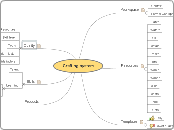par Arne Sostack Il y a 18 années
474
RPG: Dunderhill Crafting system

par Arne Sostack Il y a 18 années
474

Plus de détails
Skills should be measured in levels and affect the quality of the crafting product.
All commands should be available to anyone.
One's skill level can be increased by:
With a master
Solo
Quality of the resulting product is determined by various factors:
Skill level of the person producing the item. This may be weighted differently on each action, so that less important subtasks can be delegated to less skilled craftsmen, such as apprentices.
Quality of the resources used. Again, this may be weighted, but probably less so than skill level.
Workspace and/or tool quality.
Other factors. Weather, magic, and other effects in the game may affect the resulting product.
Random factor. Some randomness in the quality could be useful, though generally this could be achieved through more fair options, such as randomizing resource quality and allowing skilled craftsmen evaluate the resources so that they may choose the best ones.
When a project is finished, all participants should be given access to the template for the project.
A template allows the craftsperson to create an object like the original simply by adding the correct amount of each required resource. The resulting object's quality is determined as if the advanced method of object creation was used, except that all commands are considered executed by the same person.
The quality of an object created based on a template should be lower than the same object created in the advanced way.
A wide range of resources should be available to the craftspeople.
Any crafting should take place at a workspace. For some crafts, such as smithing, a formal workspace (containing an anvil and a fireplace) is necessary. For others, e.g. a woodworker cutting a figurine, it is possible to carry their workspace with them.
The crafter has a workspace, either a formal one (as in the smithy) or a project workspace which represents the project being worked on. Each workspace has a buffer to which task items can be added. A task item consists of a type, an amount, and a quality. Craft-related commands all add to the buffer, as does adding resources to the buffer. Each time a task item is added to the workspace, the workspace matches the current list of task items against the object templates that are available to see if one has all its requirements fulfilled (meaning that sequence of the task types and amounts match). If a match is found, the project is complete, and an object based on the template appears.
One might work on several projects by switching between different buffers. With a project workspace, activating a different project workspace would work, while the formal workspace would offer switching between different projects internally.
Several people can work on the same project by using the same workspace. Project workspaces would be handed from person to person, while anyone in the location of a formal workspace would be able to work on the active project.